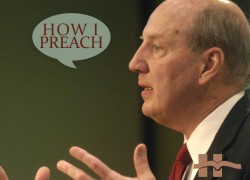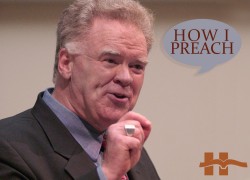aBeLOG
Welcome to the aBeLOG, a series of (hopefully!) fortnightly posts on all matters homiletical. I intend to touch on whatever grabs my attention regarding preaching—issues contemporary and ancient, ideas hermeneutical and rhetorical, personalities conservative and liberal, publications antiquarian and avant-garde. Essentially, I’m going to follow my own homiletical olfactory instincts up rabbit trails and after red herrings. Comments are always invited and appreciated.
Genesis 26:1−33
God’s blessings are sure, and obviate any need to secure them by retaliating against opposition.
Isaac finds himself in a famine, God tells him to remain where he is, in Gerar (26:1–3), and Isaac and his descendants are also promised blessing and land.
What happens next is odd: In 26:7–11, Isaac passes off his wife, Rebekah, as his sister, fearing for the safety of his own life from the hoi polloi who might seek to appropriate Rebekah. Was this fear justified?
Jerry Vines: How I Preach
Jerry Vines: And this is How I Preach …
[Jerry Vines is at the forefront of anything to do with preaching, particularly in the Baptist tradition. Author of a number of preaching books, he’s also twice been the President of the Southern Baptist Convention, steering it into a more conservative organization. Jerry has been in the pastorate for over five decades, preaching regularly (he delivered his first sermon in 1950!). Since retiring in 2005, he continues to maintain
Genesis 25:19−34
Failing to recognize God’s sovereign distribution of blessing, and despising one’s own blessing, can lead to strife.
The oracle of God in Gen 25:23, announcing the future serving of the younger by the older, explains the conflict between Esau and Jacob—a conflict that begins in the womb, that continues as the twins come out of the womb, and that persists outside the womb for the next several decades. This was a battle for the superiority and eminence that came through
Duane Litfin: How I Preach
Duane Litfin: And this is How I Preach …
[Author, pastor, professor, and seminary president—he was the seventh president of Wheaton College—Duane is an authority on all matters related to preaching. He taught at Dallas Seminary for several years, and currently serves on the Seminary Board; so that makes him one of my bosses! With a couple of doctoral degrees in the rhetorical aspects of preaching, Duane’s thinking on homiletics needs to be tapped into by every preacher.
Lifespan!
A 50-year-long study has recently shown what we all knew already: unhealthy lifestyles can reduce our lifespans.
Inadequate exercise, imprudent diet, and inadvisable smoking, potentially resulting in heart disease, diabetes, and stroke, can diminish the length of life. If you are a male in your 40s, being stricken with all three conditions will bring your life expectancy down from 78 to 55 (if you are a female, your reduction would be 20 years). If you were in your 60s,
Genesis 24:1−25:18
Mature faith trusts God to accomplish his purposes through his inscrutable design and through human action.
This pericope forms a sort of epilogue to the whole Abraham narrative. The patriarch’s exhortations to his servant regarding his desire for his seed, his son, to marry from among his own, form the last recorded words of Abraham (24:1–9). He twice mentions “Yahweh, the God of heavens” (24:3, 7). In these later days of his life, he is still confident in Yahweh’s
Paige Patterson: How I Preach
Paige Patterson: And this is How I Preach …
[Paige Patterson needs no introduction. He has been on the frontlines of the academy and the church since his seminary days in the 70s. Past-President of The Criswell College in Dallas, Texas, and of Southeastern Baptist Theological Seminary in Wake Forest, North Carolina, he is currently President of Southwestern Baptist Theological Seminary in Fort Worth, Texas. Paige has also served as President of the Southern Baptist Convention.



















 Abe Kuruvilla is the Carl E. Bates Professor of Christian Preaching at The Southern Baptist Theological Seminary (Louisville, KY), and a dermatologist in private practice. His passion is to explore, explain, and exemplify preaching.
Abe Kuruvilla is the Carl E. Bates Professor of Christian Preaching at The Southern Baptist Theological Seminary (Louisville, KY), and a dermatologist in private practice. His passion is to explore, explain, and exemplify preaching.